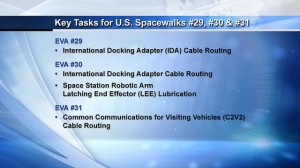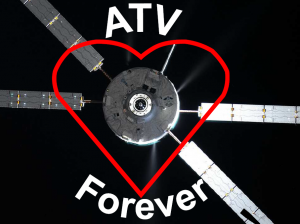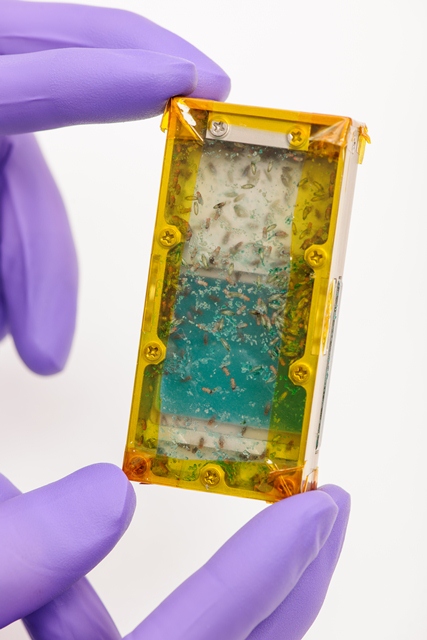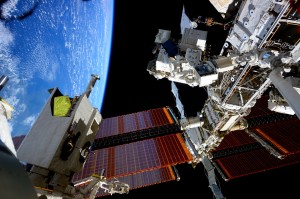I’m a plumber by profession
10/06/2015
10/06/2015
Practicing emergencies is necessary so I accept that the volunteer fire department near our home at Hochstadt runs their siren in the evening, even though it excites our 3-year-old daughter just before bedtime. We also need to practice emergencies on the International Space Station in space you cannot phone highly-trained rescue workers to come to the rescue. Astronauts must be able to fend for themselves, extinguish a fire and protect themselves from any fumes. Even radio contact with experts in control centers cannot be assumed to work in a worst-case scenario.
In today’s emergency exercise the control centres and astronauts worked together on a so-called On-Board Training or simply OBT. We had “stage directions” that defined for example that a leak would appear in the Japanese Kibo module through which air would escape.
The alarm sounded on the Space Station with its penetrating noise and the computer screens of our Flight Controller filled up with numerous error messages, proving that the International Space Station had configured itself in emergency mode. The astronauts onboard reported shortly afterwards to Mission Control Houston with the news that they had a pressure drop on the Space Station to contend with. All radio communication between crew and flight controllers began with the words “For the workout exercise:” to ensure that everybody knew it was not a real emergency, but an exercise.
The flight director in Houston declared a “Space Craft Emergency” – of preceded by “for the training exercise”. Sinje Steffen of the STRATOS team at the Columbus Control Centre checked whether Columbus was automatically reconfigured for this Rapid Depress scenario.
The astronauts convened in the meantime 350 km above close to their Soyuz spacecraft. Since the Russian capsules are the Station’s lifeboats, each astronaut has a well-defined place there. They are usually the first assembly point of crew in an emergency. Once there, they decide together on how to proceed based on the scheme “Warning – Gather – Fight”. In our emergency script scenario, the astronauts had about five hours until critical low pressure (designated as T.Res) would be reached – time enough to try to find the leaking module and possibly stop the International Space Station from ‘bleeding out’.
The astronauts followed the well-defined sequence to close various hatches to measure on which side the pressure dropped further. Slowly they were able to find their way closer and closer to the actual leak.
Columbus Flight Director Katja Leuoth and her team was busy keeping up with the falling pressure values: a long list of minimum air pressure certification values exist for all Columbus components – each of these elements had to be switched off before their critical pressure was reached. Today’s commands were “for the training exercise”, so actual commands were not issued and power was not actually switched-off…
The rapid pressure-drop (rapid depress) is one of three major emergency scenarios that are defined for the International Space Station.
Depending on the size of the leak, there are various ways to “clog the hole”: from an oversized bicycle-patch to a plasticine-like material. All sealing is done of course from inside the space station – and is easy: Compared to the vacuum of space the pressure inside the ISS is considerable higher and pushes any seal onto the leak – a clear advantage compared to repairing a bicycle inner tube…
Thomas Uhlig, Columbus Control Centre
21/04/2015

Watch the replay of the handing over here:
[youtube bsd3oOKIBLM]
10/03/2015
After 91 days of living in their new home in space they finally went outside Not to catch some fresh air of course…that would be quit dangerous!
US astronauts Barry Wilmore and Terry Virts commenced the first of three spacewalks last Saturday. It was Barry’s second spacewalk after his first one last October and Terry’s first.
The two astronauts, already nicknamed the ‘cable guys’ have to rig cables on the International Space Station for new docking ports for commercial and international spacecraft called International Docking Adapters or IDA. They will be delivered on two Space-X Dragon spacecraft in the near future.
The adapters are built by Boeing and will arrive separately as Dragon cargo that will dock to the Harmony Module or Node 2. Node 2 already has two Pressurized Mating Adapter (PMA) which are used to connect spacecraft and modules with different docking mechanisms. They resemble tunnels that connect to spacecraft.

The tasks for the U.S. spacewalks #29, #30, #31.
The goal will then be to link each International Docking Adapters to a Pressurized Mating Adapter … imagine doing it with Lego, more or less!
But like with Lego there is a possibility that one piece, in this case the Pressurized Mating Adapter could be better used elsewhere. That is the case with PMA-3. The first International Docking Adapter is relatively easy to install: it is connected to PMA-2, which is installed on the Harmony Module facing the direction the Space Station moves.
The second International Docking Adapter requires more work. The international adapter will be connected to PMA-3 but it first has to be moved from Node 3 Harmony to Node 2 Unity to face towards space.
Why all this work? The new docking adapters will be used to welcome the new commercial cargos from Space-X and Boeing , starting most likely from the last part of 2017. In the long run the two new Adapters will allow the Space Station to host one more crew from the present six.
In the meantime new cargo arrived at the Space Station bringing food, supplies and new hardware for the experiments.
It has been a busy period for the astronauts living on the ISS that in a very short period has seen the arrival of Dragon and the depart of both Dragon and the last ever European cargo spaceship ATV-5. Progress 58, the Russian cargo just arrived at the Station, will stay docked to the Station until next August.
The astronauts have a lot of work to do in any case: two more spacewalks are expected this week and a new crew will soon arrive to start Expedition 43.
Stefano Sandrelli
Cover image: Terry Virts as seen from the Cupola of the ISS and photographed by Samantha Cristoforetti on Feb.21, 2015. Credits: ESA/NASA
For more pics of the U.S. spacewalk #29: https://www.nasa.gov/mission_pages/station/expeditions/expedition42/gallery.html#.VOtMxvmG-So
23/02/2015
Time for farewells!! The Dragon spacecraft left the International Space Station earlier this week and today ESA’s ATV spaceship with the catchy name Georges Lemaître detached from the Station and will plunge after several orbits into Earth’s atmosphere. Due to the enormous heat from friction caused by its deceleration through the upper layers of air layers the spacecraft will turn into a huge fireball – a fitting end to the spacecraft that is named after one of the founding fathers of the Big Bang theory!
Unfortunately, this will be the last ATV – after five very successful missions, the project is now complete. At the Columbus Control Center (Col-CC) we provided for each flight the ground infrastructure and supplied our colleagues at ATV Control Centre in Toulouse, France, with data, video and voice connections to the International Space Station network. After ESA astronaut Samantha Cristoforetti and cosmonaut Alexander Samokutyaev closed the hatches of ATV yesterday, the Space Station was prepared for the last hours of undocking of ATVs. We turned off our little amateur radio station [https://www.ariss.org/] in Columbus as well as the external Rapidscat experiment [https://www.jpl.nasa.gov/missions/iss-rapidscat/], any radio interference with ATV’s navigation from the International Space Station should be avoided.Slowly the Space Station turned to an appropriate orientation for undocking. When the moment arrived the Space Station’s active position control was turned off completely: Georges Lemaître needs to push away from the Space Station without the mothership trying to compensate for this force.
Afterwards all that remained was for the astronauts to wave good-bye …
 ATVs are part of a large space fleet that supplies the International Space Station. When the American Space Shuttle withdrew from service the Russian Soyuz spacecraft became the only way to get people to the Space Station and back on Earth. Three astronauts share a small space – and so there is little room for other supplies.
ATVs are part of a large space fleet that supplies the International Space Station. When the American Space Shuttle withdrew from service the Russian Soyuz spacecraft became the only way to get people to the Space Station and back on Earth. Three astronauts share a small space – and so there is little room for other supplies.
Tom Uhlig, Columbus Flight Director at the DLR center in Oberpfaffenhofen/Germany
Cover image by ESA astronaut Samantha Cristoforetti: https://www.flickr.com/photos/astrosamantha/16546104212/ .
16/02/2015
Stefano Sandrelli
To learn more about the Epigenetics experiment: https://www.nasa.gov/mission_pages/station/research/experiments/1075.html Cover image: Caenorhabditis elegans — a millimeter-long roundworm with a genetic makeup scientists understand — will be central to a pair of Japan Aerospace Agency investigations into muscle and bone loss of astronauts on the International Space Station in the first few months of 2015. Image Credit: NASA06/02/2015
 Then it means you are useless since we already know about these diseases in humans, what is your purpose?
Look, try switching on your brain, please. Scientists know about the genetic diseases of humans, but it is difficult to study the genetic transmission of a disease as it spans the lifetime of a human being, around 70-80 years. We reproduce very fast: our life spans a couple of your weeks and each female lays around 600 eggs. Get where we are going? Our genome is transmitted in real-time, “live” in front of scientists eyes, to many descendants.
From your reaction it seems as though you still do not get it, do you?
But how many are going to space?
We start with a little more than 100. It is the mechanism of genetic transmission that interests scientists, understand? And we show it to them, generation after generation.
But why on the International Space Station?
Because there is no gravity up there. And gravity could be an important part of genetic transmission. Our scientists have created a beautiful experiment!
Tell me more … how does it work?
The Fruit Lab System has three components: a small housing compartment in which we launch. A second compartment is where we live and get fed and where our larvae are extracted.
What do the astronauts do with your larvae? Do they eat them? Are you fresh food?
What??? Where do you come from? The larvae are stored in a refrigerator called MELFI where our offspring are preserved and brought back to Earth for further study.
There is a third housing compartment, where we can fly freely, assuming we are not affected by weightlessness too much. Here scientists mounted a camera to watch us 24 hours a day. A sort of Big Brother for fruit flies. A number of us live in weightlessness while others live in a small centrifuge to simulate Earth’s gravity. The larvae we produce are frozen, brought back to earth and studied.
Are you really convinced that something interesting for mankind may come out of this?
Of course, this is what we aim for and the scientists whom we are trying to help. We have been helping humans to understand how their bodies function for over a century!
If you want to educate yourself, we have a dedicated blog on this experiment:
https://www.nasa.gov/ames/research/space-biosciences/fruit-fly-lab-ffl-01-engineers-blog/#.VMDVsCzhino
And Samantha Cristoforetti talked about it in her blog entry: https://plus.google.com/+SamanthaCristoforetti/posts/PGvbX97yTee
Featuring in the cover image: The habitat for astro fruit flies created especially for studies in microgravity. Credits: NASA-Dominic Hart
Then it means you are useless since we already know about these diseases in humans, what is your purpose?
Look, try switching on your brain, please. Scientists know about the genetic diseases of humans, but it is difficult to study the genetic transmission of a disease as it spans the lifetime of a human being, around 70-80 years. We reproduce very fast: our life spans a couple of your weeks and each female lays around 600 eggs. Get where we are going? Our genome is transmitted in real-time, “live” in front of scientists eyes, to many descendants.
From your reaction it seems as though you still do not get it, do you?
But how many are going to space?
We start with a little more than 100. It is the mechanism of genetic transmission that interests scientists, understand? And we show it to them, generation after generation.
But why on the International Space Station?
Because there is no gravity up there. And gravity could be an important part of genetic transmission. Our scientists have created a beautiful experiment!
Tell me more … how does it work?
The Fruit Lab System has three components: a small housing compartment in which we launch. A second compartment is where we live and get fed and where our larvae are extracted.
What do the astronauts do with your larvae? Do they eat them? Are you fresh food?
What??? Where do you come from? The larvae are stored in a refrigerator called MELFI where our offspring are preserved and brought back to Earth for further study.
There is a third housing compartment, where we can fly freely, assuming we are not affected by weightlessness too much. Here scientists mounted a camera to watch us 24 hours a day. A sort of Big Brother for fruit flies. A number of us live in weightlessness while others live in a small centrifuge to simulate Earth’s gravity. The larvae we produce are frozen, brought back to earth and studied.
Are you really convinced that something interesting for mankind may come out of this?
Of course, this is what we aim for and the scientists whom we are trying to help. We have been helping humans to understand how their bodies function for over a century!
If you want to educate yourself, we have a dedicated blog on this experiment:
https://www.nasa.gov/ames/research/space-biosciences/fruit-fly-lab-ffl-01-engineers-blog/#.VMDVsCzhino
And Samantha Cristoforetti talked about it in her blog entry: https://plus.google.com/+SamanthaCristoforetti/posts/PGvbX97yTee
Featuring in the cover image: The habitat for astro fruit flies created especially for studies in microgravity. Credits: NASA-Dominic Hart
Stefano Sandrelli
27/01/2015
After a short glance on my telemetry displays I can see indications, that the power outlet, which feeds the Columbus lights, draws some power: “COL-FLIGHT, STRATOS, Columbus lights are ON!”
The answer comes immediately: “Copy that, STRATOS, so the crew is awake!”
The astronauts are ready to kick off their day!
A standard crew day onboard ISS starts with around 1 hour of post-sleep time. Crew can have breakfast, prepare for the day and read the “Daily Summary”, a sort of newspaper, which we put together with the other control centers and which is used to provide the crew with the ISS big-picture status, comments to the daily plan, the Flight Control Teams roster, as well as a Q&A section and (sometimes) jokes and cartoons
It does not sound that different from the morning routine of any other human being preparing for work on planet Earth, does it?
The first official interaction with the Control Centers around the world is during the mDPC (“morning Daily Planning Conference”): Crew and the Flight Controllers tag-up on the daily operations, discuss deltas to the plan and address any crew question that might arise.
The termination of the mDPC marks the start of the actual work-day for the crew. 6.5 hours of their day will be divided between conducting experiments, installing new payloads, executing repairs and “housekeeping”!
In addition to the work time, 1 hour is always allocated for a midday meal, and 2.5 hours are strictly scheduled for physical exercise: crewmembers use a cycle ergometer (i.e. an exercise bike) for cardiovascular exercise, a treadmill for cardiovascular exercise – loading the skeletal system and maintaining the neuromuscular patterns for locomotion, and a Resistance Exercise Device for maintaining muscles and bones.
 Once the daily activities are completed, it is time for the eDPC (“evening Daily Planning Conference”). This is “goodnight” time: interactions with the crew on the Space-to-Ground voice channels are interrupted to allow them some well-deserved rest time, we also switch off any camera inside the space station! Only in case of contingency scenarios the Ground Teams would make contact again.
Once the daily activities are completed, it is time for the eDPC (“evening Daily Planning Conference”). This is “goodnight” time: interactions with the crew on the Space-to-Ground voice channels are interrupted to allow them some well-deserved rest time, we also switch off any camera inside the space station! Only in case of contingency scenarios the Ground Teams would make contact again.
After a round call to all control centers for any input, crew is off-duty: they can have dinner, check social media and watch TV or movies, or spend some “quality-time” sightseeing from Cupola.
Then it’s bed time: 8.5 hours of good sleep in micro-gravity
One last thing! A dedicated electronic tool is available to both Crew and Ground Teams, called OSTPV (“Onboard Short Term Plan Viewer”): it shows the so-called timeline, the schedule of the ISS and is divided in several bands for Crew and Ground, and each activity is represented by a “bar” It is driving the crew day – and it can drive astronauts crazy, as you can convince yourself …
[youtube s2gUOV3KK2k nolink]
Should you be interested in the current OSTPV: We give you a little bit of insight here.
Alessandro Rovera
29/11/2014
The Hitchhiker’s Guide to the Galaxy, as it is known, is the most successful book ever published by the publishing houses of Ursa Minor. A worthy competitor is 53 other things to do in zero gravity. Of the latter work, however, neither the author nor the content are known. At least they were not known until today.
A group of researchers from Outpost 42, in collaboration with the Antiques Academy of the Near and Remote Future argue, in fact, that they have found excerpts of the original 53 Other Things to do in zero gravity. What makes the originality of this discovery very questionable is that the name of the authors appear next to each sentence. Rather suspicious names: take a look at the section of Outpost 42 crew.
In any case, here are the 23 fragments that were discovered.
Samantha Cristoforetti
Never put your feet on the ground.
Never ask yourself: what shoes should I wear today?
Play around with a strawberry trying to catch it with your mouth without fear of dropping it on the floor.
Enjoy feeling the skin under your feet as soft as the skin of a baby
Move around just by breathing
Storing things in the highest cabinet without the help of a stick to reach it.
Never worry about using a hammer and nails: just a little velcro will do fine!
See who travels furthest without touching the walls (if you touch the air-flow sensors on Russians hatches you are disqualified!)
Never make your bed in the morning.
Rotate your home so that friends can easily find the entrance.
Use a bicycle without a saddle.
Throw the scales away: they always show zero!
Hold things with your legs while you walk with your hands.
Antonio Pilello
Practice yoga upside-down.
Swim without water.
Eat a lot without gaining weight.
Chiara Forin
Read a book in bed without holding it up
Wear a Superman costume on Halloween (even if Luca Parmitano already did this)
Cook without fear of making the floor dirty … nothing falls on the ground!
Stefano Polato
Break an egg and separate the egg white from the yolk
Stefano Sandrelli
Spend life with you head above the clouds and feel it is OK
Freefall and laugh about it.
Be heavy and fly all the same.
Stefano Sandrelli
17/11/2014